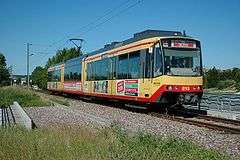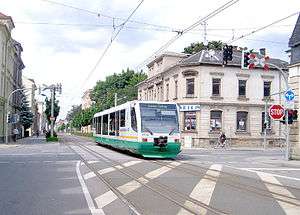Tram-train





A tram-train is a light-rail public transport system where trams run through from an urban tramway network to main-line railway lines which are shared with conventional trains. This combines the tram's flexibility and accessibility with a train's greater speed, and bridges the distance between a main railway stations and a city centre.
There is also a train-tram, which is a train modified to also run on tramlines. Generally, the tram-train and train-tram are interchangeable, although a train-tram is based on a train design modified to also run as a tram and a tram-train is based on a tram design modified to also run on a train line.
The tram-train concept was pioneered with the Karlsruhe model in Germany, and has since been adopted on projects such as the RijnGouweLijn in the Netherlands, at Mulhouse in France and in Kassel and Saarbrücken in Germany.
Technology
The tram-train often is a type of interurban,[1] i.e. they link separate towns or cities. according to George W. Hilton and John F. Due's definition.[2]
Most tram-trains are standard gauge, which facilitates sharing track with main-line trains. Exceptions include Alicante Tram and Nordhausen which are metre gauge.
Tram-train vehicles are dual-equipped to suit the needs of both tram and train operating modes, with support for multiple electrification voltages if required and safety equipment such as train stops and other railway signalling equipment. The Karlsruhe and Saarbrücken systems use ‘PZB’ or ‘Indusi’ automatic train protection, so that if the driver passes a signal at stop the emergency brakes are applied.
History
The idea is not new: In the early 20th century, interurban streetcar lines often operated on the same tracks as steam trains, until crash standards prevented track sharing. In 1924, in Hobart, Tasmania, sharing of tracks between tram and train was proposed.[3]
The difference between modern tram-trains and the older interurbans and radial railways is that tram-trains are built to meet mainline railway standards, rather than ignoring them. An exception is the USA's River Line in New Jersey which runs along freight tracks with time separation: passenger trains run by day, and freight by night.
Existing systems
Europe
- Alicante Tram, Alicante, Spain
- Badner Bahn, Vienna, Austria
- Cagliari, Italy
- Chemnitz, Germany - 750 V DC
- Kassel, Germany (2006)
- Nordhausen, Germany – 600 V DC/on-board diesel engine
- Nantes, France (Nantes-Clisson, SNCF) – light train rolling stock and not operating in urban section
- Paris, France (Line T4, SNCF) – light train rolling stock and not operating in urban section
- Mulhouse tramway, Mulhouse, France[4]
- RandstadRail, The Hague, Rotterdam and Zoetermeer, Netherlands
- Saarbrücken, Germany
- Sassari, Italy
- Stadtbahn Karlsruhe, Karlsruhe, Germany – 750 V DC/15 kV AC
- Zwickau, Germany – on-board diesel engine (light-weight RegioSprinter diesel railbuses that also operate on street tramway)
North America
- Capital MetroRail in Austin, Texas, USA - commuter rail that shares more commonality with tram-train operation, with downtown street running and usage of mainline track. Uses diesel multiple units.
- River Line (New Jersey, United States) - diesel multiple units using main line tracks between Trenton, New Jersey and Camden, New Jersey in a time-sharing agreement with the freight companies.
- The O-Train Trillium Line in Ottawa, Canada which uses European-style main line trains, and the Newark City Subway extension in Belleville and Bloomfield, New Jersey (with an FRA-imposed time-share waiver) do not qualify it as a tram-train per se , whose chief characteristic is shared-use of main-line tracks at all times.
- UTA TRAX uses former Denver and Rio Grande tracks as well as street trackage to service Salt Lake City. Between the hours of midnight and six A.M., Union Pacific freight trains use much of the trackage, up to just past 2500 S to service a number of industries along the line.
Proposed systems
Africa
- Réunion Tram Train, Réunion, France (cancelled)
- The October 6th Tram system (The O6T), Cairo, Egypt
Asia
Europe
- Aarhus Letbane, Denmark[6] (under construction, to be opened 2016)
- Braunschweig, Germany
- Bratislava, Slovakia
- Erlangen, Germany - an extension of Straßenbahn Nürnberg not initially planned to use mainline rail tracks but proposed to do so in the future. The planned line to Herzogenaurach replicates a former mainline rail line
- Grenoble, France
- Groningen, Netherlands
- île de France (Paris region), France. The system is called Tram Express by the transport authority STIF: 3 lines are scheduled (Nord, Ouest, Sud). The light train rolling stock will only roll on national rail network in northern line (Tram Express Nord). In the Western line (Tram Express Ouest) a short section of 3.6 km (2.2 mi) is an urban tram section of the 19 km (11.8 mi) line. The southern line (Tram Express Sud) is a 20 km (12.4 mi) line, 10 km will be tram section and the 10 km another will roll on national rail network.
- Kiel, Germany
- Košice, Slovakia[7] (under construction, to be opened in 2020)
- León, Spain
- Liberec — Jablonec nad Nisou, Czech Republic
- Linköping, Sweden
- Lyon, France
- Manresa, Catalonia, Spain
- Metro Mondego, Coimbra, Portugal
- Midland Metro extensions in the West Midlands conurbation, England
- Porto Metro Lines B and C, Porto, Portugal
- RijnGouweLijn, Netherlands
- Metro de Sevilla. Seville has one metro line and one tram line that are not connected, but the long-term intention is to link the metro and tram systems.
- Strasbourg, France
- Szeged, Hungary
- TramCamp, Camp de Tarragona, Catalonia, Spain
- Wrocław, Poland (2005) — 600 V DC/3 kV DC
- Riga, Latvia
- Tampere, Finland
- Turku, Finland
United Kingdom
A two-year tram-train pilot project is to be undertaken between Sheffield and Rotherham for service from 2015. If the trial proves successful, similar schemes could be rolled out across the UK.[8][9]
In March 2008 the UK Department for Transport released details of a plan to trial diesel tram-trains on the Penistone Line for two years starting in 2010.[10] There was no commitment to connect them to the Sheffield tram network, and in September 2009 the idea was withdrawn as it was deemed not economically viable for a trial due to the cost of the extra development required for the diesel engines to meet the forthcoming stringent EU emission regulations. Instead single-voltage electric tram-trains will be trialled between Rotherham and Sheffield.[11]
A tram-train trial in the Manchester area was ruled out as the Department for Transport wanted to try low-floor tram-trains, whereas Manchester Metrolink cars have high floors.[12]
In August 2009 the Liverpool Daily Post reported that a new Merseyrail tram-train link to Liverpool John Lennon Airport was under consideration. The Merseyrail Northern Line and the City Line between Liverpool Lime Street and Liverpool South Parkway were being assessed. From South Parkway the tram-trains would transfer seamlessly to a new tramway. A link from Edge Hill in the east of the city to the Arena at Kings Dock near the city centre was also being considered.[13]
Oceania
- Adelaide, South Australia – On June 5, 2008, the Government of South Australia announced plans for train-tram operation on the Adelaide Metro's Outer Harbor/Grange train lines and City West-Glenelg tramline extension as part of a 10-year A$2 billion public transport upgrade.[14]
Manufacturers
Models of tram designed for tram-train operation include:
- Alstom’s RegioCitadis and Citadis Dualis, derived from the Citadis
- Bombardier’s Flexity Link and Flexity Swift
- Bombardier-Adtranz A32.
- Siemens' Avanto (also called S70)
- Vossloh Citylink NET
See also
- Karlsruhe model
- Stadtbahn
- Interurban
- Light rail
- rail profile - light and heavy rail vehicles do not necessarily have the same rail and wheel profiles.
- Grooved rail
References
- ↑ "UrbanRail.Net > Europe > Germany > Hessen > Kassel Tram / Straßenbahn".
- ↑ Hilton & Due 1960, p. 9
- ↑ "TRAMS AND TRAINS.". The Mercury (Hobart, Tas. : 1860 - 1954). Hobart, Tas.: National Library of Australia. 12 February 1924. p. 6. Retrieved 21 April 2012.
- ↑ Haydock, David (April 2011). "France's first real tram train". Today's Railways. Platform 5 Publishing Ltd. pp. 37–40.
- ↑ "Tram-Train for Haifa-Nazareth.(Transit News)".
- ↑ "Aarhus tram-train project gets the go-ahead". Railway Gazette International. 10 May 2012.
- ↑ http://imhd.zoznam.sk/ke/media/mn/00001130/Planovane-modernizacie-elektrickovych-trati-MET-a-Integrovany-dopravny-system-IDS-20150119.pdf
- ↑ "Rotherham tram-tram project funding confirmed". Railway Gazette International. 17 May 2012.
- ↑ "First tram-trains get go-ahead for Sheffield and Rotherham". BBC News. Retrieved 17 May 2012.
- ↑ "Britain announces tram-train trials". Railway Gazette International. 18 March 2008.
- ↑ "Tram-train line given go ahead". South Yorkshire Transport Forum. Archived from the original on 2016-04-16.
- ↑ "Item 10 Rail Issues" (PDF). Transport for Greater Manchester Committee. 1 February 2008.
- ↑ "Tram link bid for Liverpool airport". Liverpool Daily Post. 3 August 2009. Archived from the original on April 6, 2012. Retrieved 20 August 2009.
- ↑ Adelaidemetro.com.au Archived July 21, 2008, at the Wayback Machine.
External links
- TramTrain - the 2nd generation: Searching for the ‘ideal’ TramTrain-city
- New TramTrain for Mulhouse - Reportage and images (english/german.)
- Construction of the TramTrain system in Mulhouse with images (english/german.)
- tram-train of Karlsruhe transformed in a subway in the center
- Leeds City Region proposal
- (Jane's) Urban Transit Systems